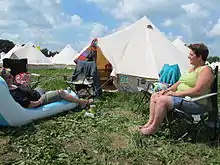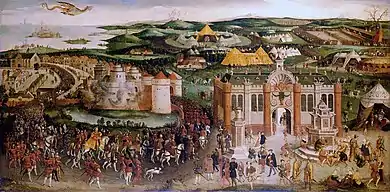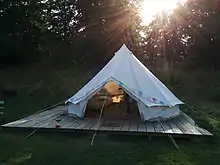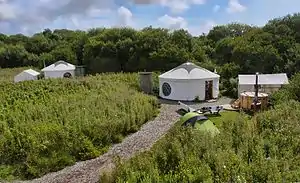Glamping
Glamping is a portmanteau of "glamorous" and "camping", and describes a style of camping with amenities and, in some cases, resort-style services not usually associated with "traditional" camping. Glamping has become particularly popular with 21st century tourists seeking the luxuries of hotel accommodation alongside "the escapism and adventure recreation of camping".[1][2][3][4]
History

The word "glamping" first appeared in the United Kingdom in 2005[5] and was added to the Oxford English Dictionary in 2016.[6] The word is new, but the concept that "glamping" connotes, that of luxurious tent-living (or living in other camping accommodations), is not. In the 16th century, the Scottish Earl of Atholl prepared a lavish experience in the Highlands for the visiting King James V and his mother. Here, the Duke pitched lavish tents and filled them with all the provisions of his own home palace.[7]

Probably the most extravagant example of palatial tent-living in history was the Field of the Cloth of Gold, a diplomatic summit in 1520 between Henry VIII of England and Francis I of France in northern France. Some 2,800 tents and marquees were erected, and fountains ran with red wine.[8]
At around the same time, the Ottomans had ostentatious, palatial tents transported from one military mission to the next. Entire teams of artisans travelled with the army to erect and maintain these imperial tents. As described by Professor Nurhan Atasoy,
The exquisite ornamentation both inside and out of the tents used by the Ottoman sultans made them imposing dwellings fit for a ruler. On ceremonial occasions tents served to create a splendid theatrical setting, as we see vividly portrayed in miniature paintings depicting banquets, audiences and celebrations which took place in the imperial tent complex over the centuries. The imperial tents were richly decorated as if they were pavilions, and often had designs resembling tiled panels, usually in floral patterns, either in appliés work using cloth of different colours, or embroidered in various stitches using silk and metal thread.[9]
Some 400 years later, in the 1920s, an African safari became "the thing to do" among wealthy Americans and British. But wealthy travelers, even those in search of adventure, were not willing to sacrifice comfort or luxury. From electric generators, to folding baths, and cases of champagne, travelers were afforded every domestic luxury while on adventure.[10]
Glamping is the modern equivalent, combining both yesterday's amenities and today's technology. Also called "boutique camping", "comfy camping", "luxury camping", or "posh camping", today's glamping features such structures as bell tents, pods, safari tents, tent cabins, tree houses, tipis, vintage caravans, vintage trailers, and yurts.[11]

See also
| Wikimedia Commons has media related to glamping. |
References
- Lickus, Jay (11 March 2015). "Have You Ever Been 'Glamping?'". Huffington Post.
- Southerden, Louise (19 March 2015). "Six of the best: New Australian glamping camps". Sydney Morning Herald.
- Devine, Darren (17 March 2015). "Glamping's yurts, podes and domes continue to lead way for Welsh tourism". Wales Online.
- "'Glamping' brings creature comforts to outdoors". USA Today. 2011-08-04. Archived from the original on 2013-12-06. Retrieved 2011-09-27.
- Harpaz, Beth (4 September 2014). "Glamping? Staycation? Travel Industry Loves Made-up Words". Today.com. Retrieved 2 February 2016.
- Criddle, Cristina (2016-07-06). "Glamping, power couple and tl;dr among words added to Oxford English Dictionary". The Telegraph. ISSN 0307-1235. Retrieved 2017-09-14.
- Lindsey, Robert. Sixteenth Century Glamping, The Atholl Hunt (PDF). Archived from the original (PDF) on 2016-08-24. Retrieved 2016-02-04.
- Edward Hall's Chronicle
- Atasoy, Professor Nurhan. "The Ottoman Tents". turkishculture.org. Turkish Cultural Foundation.
- Bull, Bartle (1992). Safari: A Chronicle of Adventure.
- "What is glamping (glamorous camping) & types of glamping accommodations". Bushcraftpro.com. Archived from the original on 20 February 2015. Retrieved 19 February 2015.

